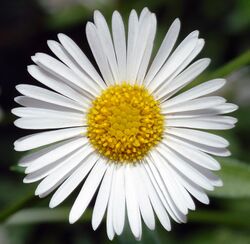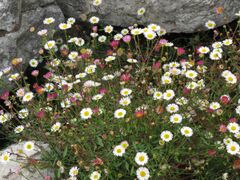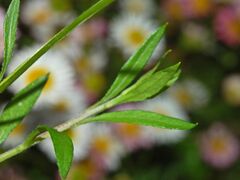Biology:Erigeron karvinskianus
| Erigeron karvinskianus | |
|---|---|

| |
| Scientific classification | |
| Kingdom: | Plantae |
| Clade: | Tracheophytes |
| Clade: | Angiosperms |
| Clade: | Eudicots |
| Clade: | Asterids |
| Order: | Asterales |
| Family: | Asteraceae |
| Genus: | Erigeron |
| Species: | E. karvinskianus
|
| Binomial name | |
| Erigeron karvinskianus DC.
| |
| Synonyms[1][2] | |
|
Synonymy
| |
Erigeron karvinskianus, the Mexican fleabane,[3] is a species of daisy-like flowering plant in the family Asteraceae, native to Mexico and parts of Central America.
Other common names include Latin American fleabane,[4] Santa Barbara daisy, Spanish daisy, Karwinsky's fleabane,[5] or bony-tip fleabane.[6]
Description
It is a vigorous, spreading perennial plant growing from woody rhizomes to a maximum height of 15 cm (5.9 in). Its leaves are located along the stem, the basal leaves dying off as the plant bolts. They are sometimes slightly toothed or lobed near the tips. The inflorescences hold one or more flower heads which are each about 1 cm (0.4 inches) wide. They have golden yellow disc florets in the center surrounded by a fringe of up to 80 white to pinkish ray florets.[5]
Flowering
In the UK, it flowers from May to October.[7]
Distribution
Erigeron karvinskianus is native to much of Mexico, Central America, Colombia and Venezuela.[8][9][10] and is naturalized in many other places,[11] including parts of Africa and Europe,[12] Australia,[6] Hong Kong,[13] Chile and the west coast of the United States.[14]
Taxonomy
The plant was first described in 1836 by Augustin Pyramus de Candolle.[15] The specific epithet refers to Wilhelm Friedrich Karwinski von Karwin,[16] who collected the plant in Mexico according to de Candolle.[15]
Cultivation
Erigeron karvinskianus is also cultivated for its daisy-like blooms, and is often confused with the closely related true daisy Bellis perennis. It is frequently grown in crevices in walls or paving,[17] where it rapidly spreads to provide a carpet of flowers.[18] It has gained the Royal Horticultural Society's Award of Garden Merit.[19][20] It was used to colonise the concrete terraces of the football stadium (Estadio Azteca) built in Mexico City for the 1970 World Cup.[17]
Gallery
References
- ↑ The Plant List, Erigeron karvinskianus DC.
- ↑ Tropicos, Erigeron karvinskianus DC.
- ↑ (xls) BSBI List 2007, Botanical Society of Britain and Ireland, https://bsbi.org/download/3542/, retrieved 2014-10-17
- ↑ Calflora taxon report, University of California, Erigeron karvinskianus DC., Latin American fleabane
- ↑ 5.0 5.1 Flora of North America, Erigeron karvinskianus de Candolle. 1836. Karwinsky’s fleabane
- ↑ 6.0 6.1 Atlas of Living Australia, Erigeron karvinskianus DC., Bony-tip Fleabane
- ↑ Claire Austin website
- ↑ Solbrig, O. T. 1962. The South American species of Erigeron. Contributions from the Gray Herbarium of Harvard University 191: 3–79
- ↑ García-Mendoza, A. J. & J. A. Meave. 2011. Diversidad Florística de Oaxaca: de Musgos a Angispermas 1–351. Universidad Nacional Autónoma de México, Ciudad Universitaria
- ↑ Nesom, G.L. and J.F. Pruski. 2011. Resurrected species of Erigeron (Asteraceae: Astereae) from Central America.Phytoneuron 2011-36: 1–10.
- ↑ CABI, Commonwealth Agricultural Bureaux International, Invasive Species Compendium, Erigeron karvinskianus (Karwinsky’s fleabane)
- ↑ Altervista Flora Italiana, Cespica di von Karwinski auf Karwin, Erigeron karvinskianus de Candolle includes photos and European distribution map
- ↑ Flora of China, Erigeron karvinskianus Candolle, 1836. 加勒比飞蓬 jia le bi fei peng
- ↑ Biota of North America Program 2014 county distribution map
- ↑ 15.0 15.1 de Candolle, Augustin Pyramus (1836). "Erigeron karvinskianum". Prodromus systematis naturalis regni vegetabilis. p. 285. https://www.biodiversitylibrary.org/page/151720. Retrieved 2014-02-11. (De Candolle used neuter endings for the specific epithets of Erigeron, but the word is masculine, being derived from the Ancient Greek word γέρων, geron, old man.)
- ↑ Hyam, R.; Pankhurst, R.J. (1995). Plants and their names : a concise dictionary. Oxford: Oxford University Press. p. 178. ISBN 978-0-19-866189-4.
- ↑ 17.0 17.1 Klein, Carol (10 August 2002). "Build your own daisy wall". The Telegraph. https://www.telegraph.co.uk/gardening/gardenprojects/3303304/Build-your-own-daisy-wall.html.
- ↑ RHS A-Z encyclopedia of garden plants. United Kingdom: Dorling Kindersley. 2008. pp. 1136. ISBN 978-1405332965.
- ↑ "Erigeron karvinskianus AGM". Royal Horticultural Society. https://www.rhs.org.uk/Plants/32487/Erigeron-karvinskianus/Details.
- ↑ "AGM Plants - Ornamental". Royal Horticultural Society. July 2017. p. 36. https://www.rhs.org.uk/plants/pdfs/agm-lists/agm-ornamentals.pdf.
External links
| Wikimedia Commons has media related to Erigeron karvinskianus. |
- Jepson Manual Treatment
- United States Department of Agriculture Plants Profile
- Calphotos Photo gallery, University of California
Wikidata ☰ Q1926297 entry
 |





